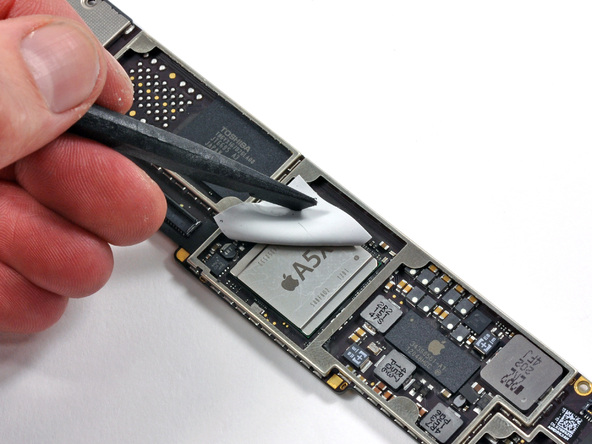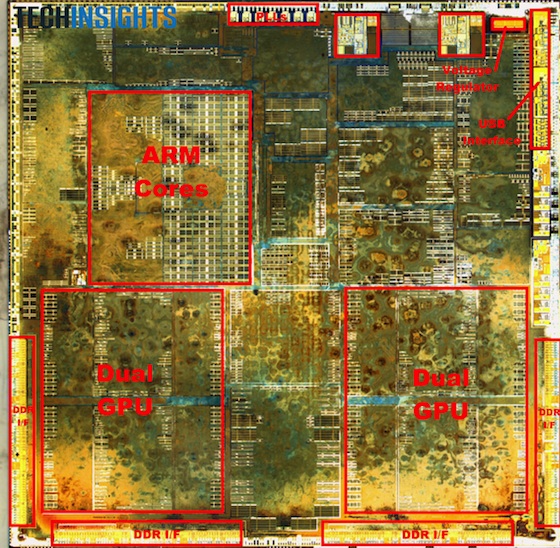Apple's iPad 3, Part 1: The Complete Retina Display And A5X Review
CPU And GPU Performance: All About Graphics
The CPU: A9 Flavor
The iPad 3 features a new SoC, the A5X. Like the preceding A5, it features a dual-core A9 ARM processor clocked at 1 GHz. We've covered the architecture of the A9 in the past, so we won't revisit the details, but for those interested in a deeper discussion, you can head back to our original A5 coverage.
| Header Cell - Column 0 | Apple A4 (iPad) | Apple A5 (iPad 2) | Apple A5X |
|---|---|---|---|
| Fab Node | 45 nm | 45 nm | 45 nm |
| Processor | 1 GHz ARM Cortex-A8 (single-core) | 1 GHz ARM Cortex-A9 (dual-core) | |
| Memory | 256 MB LP-DDR | 512 MB LP-DDR2 | 1 GB LP-DDR2 |
| Graphics | PowerVR SGX535 (single-core) | PowerVR SGX543MP2 (dual-core) | PowerVR SGX543MP4 (quad-core) |
| L1 Cache(Instruction/Data) | 32 KB / 32 KB | 32 KB / 32 KB | |
| L2 Cache | 640 KB | 1 MB |
On paper, there's really nothing to suggest improved CPU performance from the A5X. There's no change in cache size, and though there's apparently twice as much on-die RAM, it has no impact on raw computational horsepower. The new A5X seems intended to help improve multitasking support and enable a beefier graphics engine, so our GeekBench results are, not surprisingly, largely unchanged.
| GeekBench v2.2.7 Results | iPad 2 | iPad 3 | Dell Mini 1012 | LePan II | Transformer Prime |
|---|---|---|---|---|---|
| CPU | Apple A5 | Apple A5X | Atom N450 | APQ8060 | Tegra 3 |
| Architecture | Dual-core A9 | Dual-core A9 | Single-Core Atom | Dual-core Scorpion | Quad-core A9 |
| Speed | 1 GHz | 1 GHz | 1.66 GHz | 1.2 GHz | 1.4 GHz |
| Overall | 764 | 760 | 917 | 649 | 1194 |
| Integer | 691 | 687 | 910 | 709 | 1781 |
| Floating Point | 921 | 920 | 762 | 943 | 1781 |
| Memory | 830 | 825 | 1105 | 362 | 1091 |
The GPU: Double Your Pleasure
One aspect of Apple's A5X truly shines: graphics performance. Since an ultra-high-resolution display is the iPad 3’s core selling point, Apple's A5X features a significantly more powerful graphics engine optimized for the Retina display. This increases gaming potential by a lot. In fact, Apple claims the iPad 3 offers double the graphics performance of the iPad 2. How is this possible?
| GPU System-on-Chip | PowerVR SGX 535(Apple A4) | PowerVR SGX 543(Apple A5/A5X) |
|---|---|---|
| SIMD | USSE | USSE2 |
| Pipelines | 2 | 4 |
| TMUs | 2 | 2 |
| Bus Width (in bits) | 64 | 64 |
| Triangle rate @ 200 MHz | 14 MTriangles/s | 35 MTriangles/s |
Apple still employs Imagination's PowerVR SGX543 architecture, used in the iPad 2. But whereas the iPad 2 was limited to a dual-core implementation (SGX543MP2), the iPad 3’s A5X sports a muscular quad-core GPU (SGX543MP4). Incidentally, Sony's PlayStation Vita also uses a the SGX543MP4.
That hardware change is easy to spot when you inspect the A5X's die. In the annotated layout above, you can quite clearly identify each of the four GPU cores. It also appears that RAM accesses has changed to accommodate the increased need for bandwidth. The A5 employed a pair of memory interfaces; UBM's image above suggests four on the A5X. To get a more illustrative story, though, let's look at GLBenchmark.
Get Tom's Hardware's best news and in-depth reviews, straight to your inbox.
| GLBenchmark 2.1.2*native resolution | iPad 2 | iPad 3 | Kindle Fire | LePan II | Transformer Prime |
|---|---|---|---|---|---|
| GPU | PowerVR SGX543MP2 | PowerVR SGX543MP4 | PowerVRSGX540 | Adreno 220 | Tegra 3 (ULP GeForce) |
| Egypt Standard* | 6661 frames (59 FPS) | 6709 frames (59 FPS) | 2847 frames (25 FPS) | 3485 frames (31 FPS) | 5388 frames (48 FPS) |
| Egypt Fixed Time Step* | 47.598 s (59 FPS) | 47.261 s (60 FPS) | 116.138 s | 112.659 s (25 FPS) | 69.055 s (41 FPS) |
| Egypt Off Screen (720p) | 10 146 frames (90 FPS) | 15 663 frames (139 FPS) | 2516 frames (22 FPS) | 3603 frames (32 FPS) | 6496 (58 FPS) |
| Pro Standard* | 2962 frames (59 FPS) | 2975 frames (60 FPS) | 1981 frames (39 FPS) | 2140 frames (43 FPS) | 2726 frames (54 FPS) |
| Pro Fixed Time Step* | 20.868 s (60 FPS) | 20.857 s (60 FPS) | 34.658 s | 31.982 s (39 FPS) | 24.189 s (52 FPS) |
| Pro Off Screen (720p) | 7352 frames (147 FPS) | 12546 frames (251 FPS) | 2277 frames (46 FPS) | 2332 frames (47 FPS) | 3717 frames (74 FPS) |
According to the standard tests in GLBenchmark, nearly identical scores on the iPad 2 and iPad 3 imply similar perceived overall gaming performance. That doesn't seem like it'd blow you away, but it's actually pretty amazing when you consider the iPad 3's 2048x1536 native resolution. Comparing these two devices at their native resolutions is by no means an apples-to-apples match-up. But it is cool that the iPad 3’s A5X delivers the same performance with four GPU cores at 2048x1536 resolution as the iPad 2’s A5 with two cores at 1024x768.
Comparing the raw graphics performance of each hardware implementation using GLBenchmark's off-screen tests reveals that the A5X delivers about 1.5-2x more performance than the A5. More interestingly, the Tegra 3-based Transformer Prime actually falls behind the older iPad 2. In fact, when we compare the Transformer Prime to the iPad 3, we see a two- to three-fold jump in performance favoring Apple's tablet.
| GLBenchmark 2.1.2 | iPad 2 | iPad 3 |
|---|---|---|
| Triangle Test | 65.0 Mtriangles/sec | 129.2 Mtriangles/sec |
| Triangle Texture Test | 58.0 Mtriangles/sec | 120.8 Mtriangles/sec |
| Triangle Texture Test, Vertex Lit | 45.6 Mtriangles/sec | 93.6 Mtriangles/sec |
| Triangle Texture Test, Fragment Lit | 43.5 triangles/sec | 92.3 Mtriangles/sec |
According to Imagination, its PowerVR tile-based deferred rendering architecture is highly dependent on memory bandwidth, which means there's a direct relationship between throughput and triangle rates. Based on our results from the iPad 3, it's pretty clear that graphics performance improvements are related both to a more complex GPU and greater bandwidth. The iPad 2 and iPad 3 seemingly both employ 800 MT/s LP-DDR2 by way of a dual-channel configuration. However, the iPad 3 utilizes four 32-bit memory interfaces, which is two more than its predecessor.
Current page: CPU And GPU Performance: All About Graphics
Prev Page Safari Downsamples Your Images, No HD Next Page The New iPad: The Best-Looking, With Caveats-
tomfreak the requirement to use adapter to use usb and sd card = minus 50% score for any tablet. Period.Reply -
joytech22 On the CPU and GPU performance page, there's a typo.Reply
When comparing the three iPads, the iPad 2 and iPad 3 are both said to be using PowerVR SGX545 GPUs (core-count is correct) while the table below it comparing SoCs the models are completely different and listed as SGX543.
I smell something fishy, dinner must almost be ready! :D -
amk-aka-Phantom Tomfreakthe requirement to use adapter to use usb and sd card = minus 50% score for any tablet. Period.Reply
My thoughts exactly. I don't care that it outputs 3x FPS over Transformer Prime; the latter can actually integrate into my devices' ecosystem and that's what matters. I'm not buying any tablet or phone without inbuilt memory card reader. -
amk-aka-Phantom Though, of course, it's really sad that Apple is beating Asus on the graphics front. Really, really sad.Reply -
amk-aka-Phantom tc17I have a bridge to sell you if you believe this retina nonsense, on a tiny 10" screen.Reply
After playing around with most hi-end Android devices AND iPhone 4S/iPad 2, I happen to believe this "nonsense". Everything looks so much more hi-res... but that's only Android's fault. When are they going to fix the menu animation lag and make everything more hi-res? ICS kind of did a good job on it, though, and now it actually looks NOTHING like iOS and is beautiful.
Of course, the menu animation lag and low-res icons can't make me shift to Apple, especially now that I run ICS on my netbook (try that, Apple... oh wait, your toy MacOS IS already like a tablet OS, lol) - same way that MacOS's ability to take screenshots of a selected area of the screen can't make me shift from Windows/Ubuntu. It's just not nearly enough to compensate for the important features I'll lose. Sure enough, there're tons of people to whom all of them don't matter and they'll just go with the most hyped thing out there, but I prefer to know what I'm paying for. It's a habit that pays off on the long run. -
killerchickens I wish toms would stop using the bs retina display term considering the ipad 3's display isn't even close to the original standard.Reply -
bernardv 2048x1536 on a 10" screen? This is a joke, 0 value to 99.9% of end users. A fanboy excuse for throwing money away.Reply
The author comments it is suitable for watching movies. Which movie is even available in such a resolution??? For watching movies in your lap on 10", 720p is more than enough.

